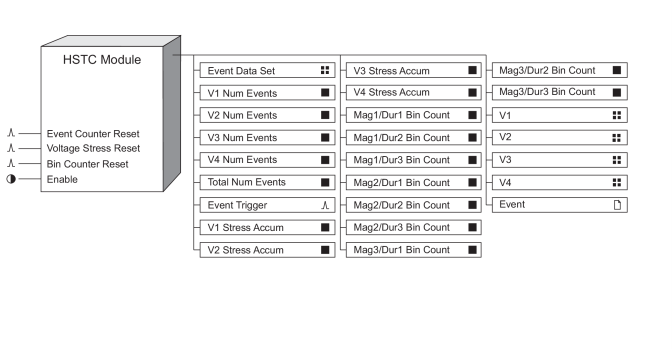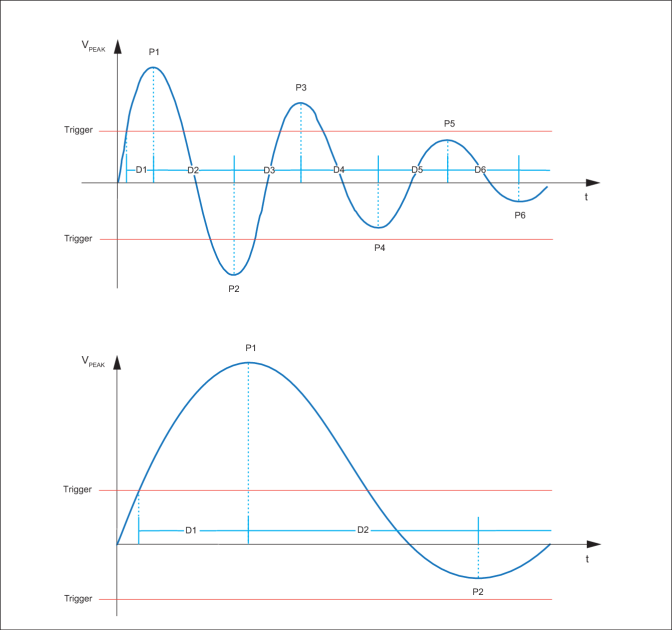HSTC Module
The HSTC (High-Speed Transient Capture) module monitors voltage inputs and captures sub-microsecond, high-voltage transients that may not be detected by the standard Transient module.
Module icon
![]()
Overview
Conditions that define a voltage transient event are configured in the HSTC module setup registers. When these conditions are detected, the HSTC module captures the event and provides the following data for all voltage phases:
- Transient event data such as peak magnitude and duration.
- Transient event statistics such as the number of high-speed transients, and accumulated voltage stress.
- Waveform data for all voltage phases.
Data captured by the HSTC module is recorded by the Data Set Recorder module and the HSTC Waveform Recorder module.
See Detailed module operation HSTC framework for more information.

Output register content is cleared if you re-link any of the inputs, or make any changes to the setup registers. To save the information, ensure that the data has first been uploaded before re-linking inputs or changing setup registers.
notice
data Loss
Ensure that all important data has been recorded before modifying the HSTC module.
Failure to follow these instructions can result in data loss.
NOTE: The registers and settings available in this module depend on the device or node you are configuring, as well as its firmware and template versions. Not all registers or settings are available on all devices or the Virtual Processor, and labels may vary.
Inputs
 Event Counter Reset
Event Counter Reset
Pulsing this input clears the V1-V4 Num Events, and Total Num Events output registers.
 Voltage Stress Reset
Voltage Stress Reset
Pulsing this input clears the V1-V4 Stress Accum output registers.
 Bin Counter Reset
Bin Counter Reset
Pulsing this input clears all magnitude and duration bin counter output registers (Mag1/Dur1 to Mag3/Dur3 output registers).
 Enable
Enable
This input enables or disables the module. When the Enable input is false, the module is disabled. When the Enable input is true, the module state is determined by the Enable setup register. Linking this input is optional. If you leave it unlinked, the module state is determined by the Enable setup register.
| Enable input | Enable setup register | Module state |
|---|---|---|
| false | disabled | disabled |
| false | enabled | disabled |
| true | disabled | disabled |
| true | enabled | enabled |
| unlinked | disabled | disabled |
| unlinked | enabled | enabled |
Setup registers
 Magnitude Threshold
Magnitude Threshold
This register defines the magnitude (VRMS) the input voltage must exceed to trigger a high-speed transient capture.
 Duration Threshold
Duration Threshold
This register defines how long (μs) the input voltage must remain above the Magnitude Threshold to trigger a high-speed transient capture.
NOTE: If the Duration Threshold is set to 0 (zero), the HSTC module triggers a high-speed transient capture every time the input voltage exceeds the Magnitude Threshold.
 Voltage Reference
Voltage Reference
This register specifies the voltage reference for high-speed voltage transient captures.
| Vn | Voltage transients are measured from line to neutral (L-N) |
| Ve | Voltage transients are measured from line to earth (L-E) |
 Event Priority
Event Priority
This register allows you to assign an event priority to events generated by the HSTC module. See the Event output register description for more information.
 Enable
Enable
This register enables or disables the module. When set to disabled, the module is disabled. When set to enabled, module operation is determined by the state of the Enable input.
 Dur 1/2 Bin Threshold, Dur 2/3 Bin Threshold
Dur 1/2 Bin Threshold, Dur 2/3 Bin Threshold
Captured transient events are sorted into 3 bins based on the duration of the event. These registers define the boundary separating transient duration bins 1 and 2, and bins 2 and 3.
 Mag 1/2 Bin Threshold, Mag 2/3 Bin Threshold
Mag 1/2 Bin Threshold, Mag 2/3 Bin Threshold
Captured transient events are sorted into 3 bins based on the magnitude of the event. These registers define the boundary separating transient magnitude bins 1 and 2, and bins 2 and 3.
Output registers
 Event Data Set
Event Data Set
This register provides high-speed transient data such as peak voltage magnitude, average voltage and transient trigger timestamp. The HSTC Event Data Set output cannot be read directly. It is linked to the Data Set Recorder module Source input and viewed via the Data Log contents.
See HSTC Event Data Set for additional information.
 V1 Num Events, V2 Num Events, V3
Num Events, V4 Num Events
V1 Num Events, V2 Num Events, V3
Num Events, V4 Num Events
These numeric registers display the number of high-speed transients detected on voltage phases V1, V2, V3 and V4, respectively.
 Total Num Events
Total Num Events
This numeric register displays the sum of high-speed transients detected on all voltage phases (V1-V4).
 Event Trigger
Event Trigger
This register generates a pulse for each captured high-speed transient event.
 V1 Stress Accum, V2 Stress Accum,
V3 Stress Accum, V4 Stress Accum
V1 Stress Accum, V2 Stress Accum,
V3 Stress Accum, V4 Stress Accum
Voltage stress is expressed as the product of the voltage transient magnitude and the voltage transient duration. These registers display the accumulated voltage stress in volts-seconds (V·s) for each voltage phase (V1 through V4).
 Mag1/Dur1 Bin
Count, Mag1/Dur2 Bin Count, Mag1/Dur3 Bin Count
Mag1/Dur1 Bin
Count, Mag1/Dur2 Bin Count, Mag1/Dur3 Bin Count
These registers display a count of the total number of voltage transients stored in the Mag1/Dur1, Mag1/Dur2, Mag1/Dur3 bins, respectively.
 Mag2/Dur1 Bin Count, Mag2/Dur2 Bin Count, Mag2/Dur3 Bin Count
Mag2/Dur1 Bin Count, Mag2/Dur2 Bin Count, Mag2/Dur3 Bin Count
These registers display a count of the total number of voltage transients stored in the Mag2/Dur1, Mag2/Dur2, Mag2/Dur3 bins, respectively.
 Mag3/Dur1 Bin Count, Mag3/Dur2 Bin Count, Mag3/Dur3 Bin Count
Mag3/Dur1 Bin Count, Mag3/Dur2 Bin Count, Mag3/Dur3 Bin Count
These registers display a count of the total number of voltage transients stored in the Mag3/Dur1, Mag3/Dur2, Mag3/Dur3 bins, respectively.
 V1, V2, V3, V4
V1, V2, V3, V4
These registers contain transient waveform data captured on voltage phases V1-V4. They are linked to the Source inputs of the HSTC Waveform Recorder (V1-V4) modules. For example, the HSTC V3 output is linked to the HSTC Waveform Recorder 3 module Source input. These outputs cannot be read directly and must be viewed using a waveform viewer such as ION Setup.
 Event
Event
All events are recorded in the Event register.
Possible events and their associated priority numbers are:
Event priority group | Priority | Description |
|---|---|---|
Setup change | 10 | Input links, setup registers or labels have changed. |
High-speed transient detected | * | High-speed transient detected on V1, V2, V3 or V4. |
* The priority of this event is determined by the value in the EvPriority setup register. | ||
The Event output register stores the following information for each ION event: time stamp, priority, cause, effect, and any values or conditions associated with the cause and effect.
Responses to special conditions
The following table summarizes how the High-Speed Transient module behaves under different conditions.
| Condition | Response of output registers |
|---|---|
| The Source inputs are not available. | All output registers are not available. |
| The Enable setup register is enabled. | The module is enabled, or disabled based on the Enable input. |
| The Enable setup register is disabled. | The module is disabled. |
| Any setup register is modified. | All output register values are cleared. |
| The device is powered-up. | The output registers retain the values stored on the previous shutdown. |
Detailed module operation
HSTC framework
HSTC Event Data Set
The Event Data Set output register is linked to the Source input of the Data Set Recorder and contains the following high-speed transient information:
| Parameter | Description |
|---|---|
|
Peak Voltage Magnitude |
The maximum absolute magnitude of the high-speed voltage transient event. |
|
Rise Time |
The amount of time between when the voltage exceeds the Magnitude Threshold and reaches the peak voltage magnitude. |
|
Duration |
The amount of time the voltage exceeds the Magnitude Threshold. |
|
Voltage Stress (volt-seconds) |
The product of the transient voltage magnitude and transient duration. |
|
Average Voltage |
The Voltage Stress divided by transient duration. |
|
Trigger Timestamp |
The moment in time that the high-speed voltage transient was detected. i.e. when the voltage Magnitude Threshold and Duration Threshold are exceeded. |
|
Magnitude/Duration Data Pairs |
The HSTC module provides up to 6 Magnitude/Duration pairs, P1/D1 to P6/D6, to help differentiate between oscillatory and impulsive transient events. See the images below for a representation of Magnitude/Duration pairs in oscillatory and impulsive transient events. |

HSTC Statistics: Number of high-speed transient events
The HSTC module keeps track of the number of high-speed transient events detected on each voltage phase as well as the total number of unique events. The per-phase and total unique event counters increment by 1 for each event until Event Counter Reset input is pulsed.
Refer to the examples below to see how the per-phase and total unique events are updated when new high-speed transients are detected:
- Transient detected on voltage phase V1.
- Transient detected on voltage phase V1, V3 and V4.
- Transient detected on all voltage phases.
- Transient detected on voltage phase V1.
| Voltage phase | Number of high-speed transients |
|---|---|
| V1 | 4 |
| V2 | 1 |
| V3 | 2 |
| V4 | 2 |
| Total unique events | 4 |
HSTC Statistics: Magnitude/Duration bins
Captured high-speed transient data is sorted into magnitude and duration bins to aid in the classification of the event. Data is sorted based on read-only magnitude and duration thresholds set in the HSTC module setup registers.
NOTE: Transient magnitude is stated in peak volts (VPEAK) within the Magnitude/Duration bins.
When a high-speed transient is captured on any voltage phase, the corresponding Magnitude/Duration bin counter increments by one. If a high-speed transient is captured on all 4 voltage phases, the corresponding Mag/Dur Bin Count will increment by 4.
Refer to the examples below to see how the Magnitude/Duration bin counters are updated when new high-speed transients are captured:
- 1000 VPEAK, 135 μs transient captured on all voltage phases.
- 6000 VPEAK, 10 μs transient captured on voltage phase V3 only.
- 1800 VPEAK, 50 μs transient captured on voltage phases V1, V3 and V4.
|
Dur1 Duration ≤ 32 µs |
Dur2 32 µs < Duration < 130 µs |
Dur3 130 µs ≤ Duration < 20000 µs |
|
|
Mag1 Magnitude ≤ 1500 V |
0 | 0 | 4 |
|
Mag2 1500 V < Magnitude < 4000 V |
0 | 3 | 0 |
|
Mag3 4000 V ≤ Magnitude < 10000 V |
1 | 0 | 0 |